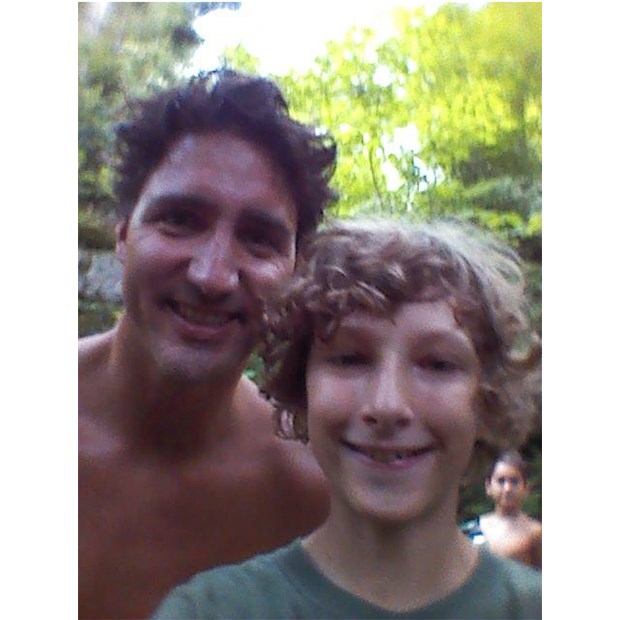The world went gaga last week when the PM was snapped (again) baring his manly torso, this time on a beach in B.C. (and complete with surfboard).
It’s not the first time this summer either.
Back in July, a family hiking in Gatineau Park in Ottawa were surprised to run into Canada’s leader hiking shirtless. Prime Minister Justin Trudeau obliged them by posing for a photo.
Before he was the PM, Trudeau appeared sans shirt in various photos, including at the weigh-in for his (very, very) amateur boxing match against now-disgraced-senator Patrick Brazeau.
One thing Trudeau has done better than virtually every other Canadian leader (except, perhaps, his own father, Pierre Elliot Trudeau) is use his looks and personality to help sell his brand and his message — two things that are inextricably intertwined when it comes to our PM.
It does get a little cloying at times (and a lot cloying at others), but you can’t deny his success at wooing both the media and the public.
He’s mostly beloved here, but also abroad, practically singlehandedly raising Canada’s global profile by dint of his progressive message, yes, but also by his flowing locks, limpid baby-blues and athletic (but not so muscular as to be intimidating) upper body.
This isn’t a column about our attractive prime minister, though. The thing is, Trudeau isn’t the first world leader to be photographed topless. Ronald Reagan did it; so, too, did Bill Clinton. Barack Obama’s done it. And who hasn’t seen a topless image of Russian president Vladimir Putin, the tiger-tranqing, horseback-riding, judo-chopping manliest man of all world leaders.
Heck, even Tony Clement, the man who would be king of the Canadian Conservatives, shared a topless Instagram pic a few months ago.
No, Trudeau isn’t unique in showing skin.
Politicians often appeal to baser instincts, to emotion-inducing rhetoric, when trying to garner support or galvanize the populace to a cause, but often the instincts appealed to lie above the belt.
In the past decade, though, the media and the public seem to delight more and more in these sexualized images of certain world leaders.
Can you imagine a similar reaction if a female leader did the same, used skin to help push her agenda or improve her profile? What if German chancellor Angela Merkel was photographed “casually” strolling along in a string bikini? Or Chilean president Michelle Bachelet posed for selfies in a mini and halter-top?
They would be denigrated and criticized (both for their choice to be photographed that way, but also for their choice of attire, hairstyle, makeup etc.), but also attacked for pushing back progress, for trying to use their wiles for political gain. In short, it could end their careers.
For male leaders, though, it seems to have the opposite effect. When a man does the same, his attributes are ranked and rated, sure, but rarely criticized.
When male politicians show skin, it isn’t casual. It’s very deliberate. A tanned, toned torso conveys health and virility — attributes we have always prided in our leaders. Look at political propaganda from the Assyrian kings (who basically wrote the book on how to rule an empire) at the height of their power, down through the Egyptians and Romans, and through to today.
We want our leaders to be vigorous and decisive, and one way to portray that is through the symbolism of their physical strength and apparent potency.
Despite our technological advances, we’re not that much different from the ancients who preceded us.
But we should be.
Because there are better attributes we should be prizing in our leaders. This kind of light fetishization of male leaders reached an extreme and ridiculous example a few months ago when, for several weeks, the topic of Republican presidential candidate Donald Trump’s small hands (and how they could reflect on the size of other parts of his anatomy) became part of political discourse.
I’m not saying confidence and decisiveness aren’t important in a leader. They certainly are.
But also important are qualities like intelligence, creativity, broadmindedness, vision, critical thinking skills, empathy, thoughtfulness and humility.
One thing a good leader doesn’t need is a sexy torso, that’s not a leadership quality. (Just ask Winston Churchill, though there’s a pretty good pic you can find of him in a one-piece bathing suit.)
It’s a difficult thing in this self-obsessed, narcissistic, social-media driven culture not to be taken in by the symbolism of leadership, rather than actual leadership.
But as society becomes more and more complex, it’s the cerebral leader with a touch of humility we should be prizing.
Not the guy who looks good with his shirt off.
Mark Gentili is the managing editor of Sudbury.com and Northern Life.
